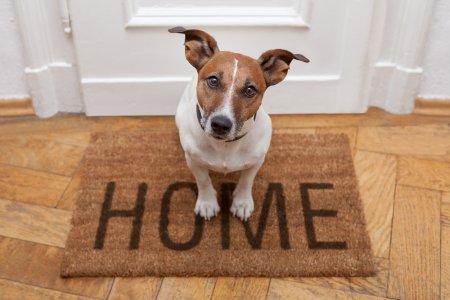Top Tips for Moving With Pets
Top Tips for Moving With Pets
1. Get Prepared Before You Go
Be sure your pet has a collar with an updated tag and prepare the proper travel arrangements. If you’ll be driving, I recommend keeping your dog in a crate and your cat in a carrier, as it is by far the safest method.
That being said, it’s important to properly restrain the crate or carrier in your vehicle as well, so you’ll want to choose one with tie-down straps.
While you could technically secure most any crate in your vehicle using elastic or rubber bungee cords, these are not secure enough in an accident, putting your pet at risk of injury.
Keep in mind, also, that putting your pet into a crate, carrier or secure harness is for both their safety and yours. An unrestrained pet can be a distraction to the driver or could crawl under their feet, causing an accident.
In an accident, an unrestrained pet can also turn into a projectile, which is life-threatening for your pet and other passengers, who could be struck by the pet.
You’ll want to choose a crate or carrier that fits your pet snugly, with enough room to be comfortable but not excess room (which poses a risk to your pet in an accident). Your pet should then be secured into the back seat or cargo area of the vehicle — notthe front passenger seat.
If you must travel by air, call the airline and ask about their procedures for pets on the plane, prior to boarding and after unloading. Choose the shortest flight possible (and make it a direct flight if at all possible).
Be sure your pet is acclimated to his crate long before the trip arrives. There are also specialty services that actually make all the travel arrangements for you.
2. Keep Pets Safe on Moving Day
In the flurry of packing and moving boxes and furniture, pets can become anxious and disoriented and may attempt to flee. Prepare a safe room to keep pets, complete with all of the essential items (food, water, bed, toys and a litterbox for cats).
If lots of people will be coming and going, put a sign on the door warning people not to let your pets out. Also try to keep your pet’s routine as normal as possible in terms of meal times, walks and trips outside to potty.
3. Travel Day Tips
When your travel day arrives, feed your pet a light meal about four hours before you leave. Hopefully, your dog or cat has already been well acclimated to traveling because you took him on multiple short trips ahead of time in preparation.
If he’s a nervous traveler, think twice before administering a sedative, which may cause potentially dangerous changes in heart rate, function and balance (and should definitely be avoided in dogs with epilepsy or cardiovascular disease).
I prefer to use homeopathic Aconite if the pet is feeling profound anxiety or fear. There are also a variety of calming herbs you can investigate, including holy basil, rhodiola, chamomile and valerian.
To help reduce anxiety naturally, consider giving flower essences orally or topically before, during and after travel. You can also mist the air around your dog’s carrier with pet-friendly essential oils a few days before travel.
An item of your clothing added to the crate can also add a calming and familiar scent.
4. Arriving to Your New Home
Once you’ve arrived, resist the urge to let your cat or dog roam freely to explore. Instead, set up a room for pets to get acclimated to the new environment. Include their crate, bed, food, water, toys and litterbox for cats.
As your pet adjusts and seems more comfortable, gradually allow him access to more rooms of the house. Slowly move your cat’s litterbox to its permanent location (moving it about 1 foot a day until it’s in the desired location).
5. Keep an Eye on Your Pet’s Mood
Most likely, your pet will adjust just fine to your new pad. He may even like it more than your old abode.
Continue calming herbs and flower essences until you see your pet’s behavior return to normal, but do keep a close eye on your pet for unusual changes in behavior, such as not eating or drinking or not using the litterbox the first few weeks.
These are signs that your pet may be suffering from anxiety or feel traumatized by the move. Try to help your pet feel safe in the new space by speaking to him calmly, using an anxiety wrap and trying to engage him in playtime. Let him advance at his own pace and don’t try to force him out of his “safe” room.
In the short-term, species-specific pheromones, such as the D.A.P. diffuser for dogs and Feliway for kitties, may positively affect your pet’s emotional state and behavior, as will TTouch, a calming form healing touch. If your pet is not adjusting to your new environment as she should, consult with a positive trainer or behaviorist to prevent the situation from getting worse.
